
Our enteroendocrine cells (EECs) are important because they influence obesity in ways that are not yet fully understood. The gut microbiota influence the EECs, also in ways that we don’t intellectually grasp. But the potential is breathtaking.
The hope is that metabolic diseases like type 2 diabetes and obesity can be controlled by adjusting the production of gut hormones through diet. A possibility is that manipulating the populations of gut bacteria could accomplish this. At present, however, it is not even clear whether the gut hormone anomalies that show up with metabolic disease are cause, effect, or both.
Some EECs are found in the pancreas and stomach, but mostly they grow in the small intestine. EECs act as chemoreceptors that sense the presence of nutrients. They secrete gastrointestinal hormones or peptides that send messages about those incoming substances, and basically control the functions of the digestive tract.
EECs prepare the body to deal with whatever chemicals are entering, and regulate food intake, lipid metabolism, glucose manufacture, and energy expenditure. They also detect harmful substances and initiate defensive responses if necessary.
The intestinal lining is designed to squeeze maximal utility from its limited real estate. Tiny finger-like projections cover the whole surface, and EECs start out as gut stem cells that live in the spaces or “crypts” between the villi. They differentiate into about 15 kinds of cells, and each one only lives from three to five days, so they are constantly being replaced. By necessity, they share quarters with their roommates, the members of the gut microbiome.
Our EECs, and 400 to 1,000 species of bacteria, marinate in each other’s secretions and relate to each other in ways we are only beginning to guess at. For instance, did our EECs evolve with such short lifespans in order to obligingly feed the gut bacteria with their dead fragments? What benefits do our cells receive in return?
Types of EECs
One subdivision is the I cell, which makes CCK, a hormone whose production is stimulated by dietary fat. It then helps to digest fat and protein in the upper stretch of the small intestine. (Just to hint at how complicated this whole picture is, CCK is also released from the central nervous system.) When obesity is the problem, food intake is an issue, as a report from Nutrition.org tells us:
CCK also stimulates pancreatic enzyme secretion and inhibits gastric emptying and food intake… The food intake inhibition effect is observed relatively shortly after food ingestion; however, its duration is also brief.
L cells make GLP-1, which regulates appetite and food intake “by directly stimulating anorectic pathways in the hypothalamus and brainstem and by acting through the vagus nerve,” and GLP-2, which has something to do with obesity-associated inflammation. Here is one clue about how the gut bacteria fit into the picture:
Basal GLP-1 levels have been observed to be significantly increased in obese rodents with chronic administration of the prebiotic fiber oligofructose compared to the nonfermentable fiber cellulose. In the same line, chronic administration of nondigestible carbohydrates in humans, which are fermented by intestinal microflora, have been shown to increase postprandial GLP-1 levels…
L cells also make PYY, in such sub-varieties as PYY1-36 and PYY3-36. The latter can “potently decrease appetite and reduce weight gain.” Such prebiotics as fructooligosaccharides (found in onion, garlic, and other vegetables and fruits) are metabolized by the intestinal microflora in such a way as to affect the sensation of satiety.
Feeling full is good, because it reduces the likelihood that a person will overeat. But in an already obese subject, the work of PYY is somehow interfered with, which indicates another way in which the microbiota might be enlisted to help out.
Your responses and feedback are welcome!
Source: “Diet: Friend or Foe of Enteroendocrine Cells — How It Interacts with Enteroendocrine Cells,” Nutrition.org, January 2012
Photo credit: euthman via VisualHunt.com/CC BY

 FAQs and Media Requests:
FAQs and Media Requests: 











